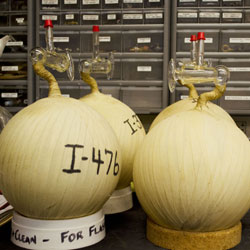In 2024, the yearly average level of the greenhouse gas carbon dioxide (CO2) rose faster over the prior year than ever before in the 67-year-old Keeling Curve record. When researchers took the average readings for all 12 months in 2024, the average was 3.58 parts per million (ppm) higher than for 2023’s average. That broke the record for largest jump … Read More
Note on recent increased day-to-day variability
An observer of Keeling Curve data queried last week why there’s such a spread in atmospheric CO2 measurements this year. In response, Scripps CO2 Program Director Ralph Keeling offered the following: “It’s true the Mauna Loa Observatory (MLO) record typically has considerable day-to-day variability in the first half of the calendar year. It’s also true that this type of variability … Read More
During Year of Extremes, Carbon Dioxide Levels Surge Faster than Ever
Carbon dioxide is accumulating in the atmosphere faster than ever — accelerating on a steep rise to levels far above any experienced during human existence, scientists from NOAA and Scripps Institution of Oceanography at the University of California San Diego announced today. Scientists at Scripps Oceanography, which initiated the CO2 monitoring program known as the Keeling Curve at Mauna Loa in 1958 and … Read More
Largest Year–Over-Year Gain in Keeling Curve Set in March
New record for largest 12-month gain in carbon dioxide concentration ever observed The monthly average concentration of carbon dioxide in the atmosphere measured at NOAA’s Mauna Loa Observatory in March 2024 was 4.7 parts per million (ppm) higher than that recorded in March 2023, setting a new record and revealing the increasing pace of CO2 addition to the atmosphere by … Read More
The Keeling Curve Hits 420 PPM
Levels of the greenhouse gas carbon dioxide eclipsed 420 parts per million for the first time in human history in 2021. Scripps Institution of Oceanography updated this animation, which explains the rise of carbon dioxide concentration in the atmosphere over the past 300 years and the measurement our researchers collect at Hawaii’s Mauna Loa, known as the Keeling Curve. When … Read More
Why COVID Didn’t Have a Bigger Effect on CO2 Emissions
The COVID-19 pandemic caused carbon dioxide (CO2) emissions from fossil fuels to drop in 2020 by seven percent compared to 2019. This decrease in emissions slowed the increase in atmospheric CO2 compared to what would have occurred without the pandemic. It was too small and too brief, however, to stand out strongly in individual CO2 records, such as the Keeling … Read More
Another Climate Milestone Falls at Mauna Loa Observatory
Peak carbon dioxide levels surpass 411 parts per million for May
American Chemical Society to Honor Keeling Curve in June 12 Ceremony
Scripps Oceanography lab monitoring atmospheric CO2 named National Historic Chemical Landmark
What Does This Number Mean?
Repost of April 2013 entry The Mauna Loa carbon dioxide (CO2) record, also known as the “Keeling Curve,” is the world’s longest unbroken record of atmospheric carbon dioxide concentrations.
A Keeling Curve Funding Update – April 2015
The Scripps Institution of Oceanography, UC San Diego O2 and CO2 programs have received funding from multiple sources that put these operations on a relatively secure footing for the next few years.






